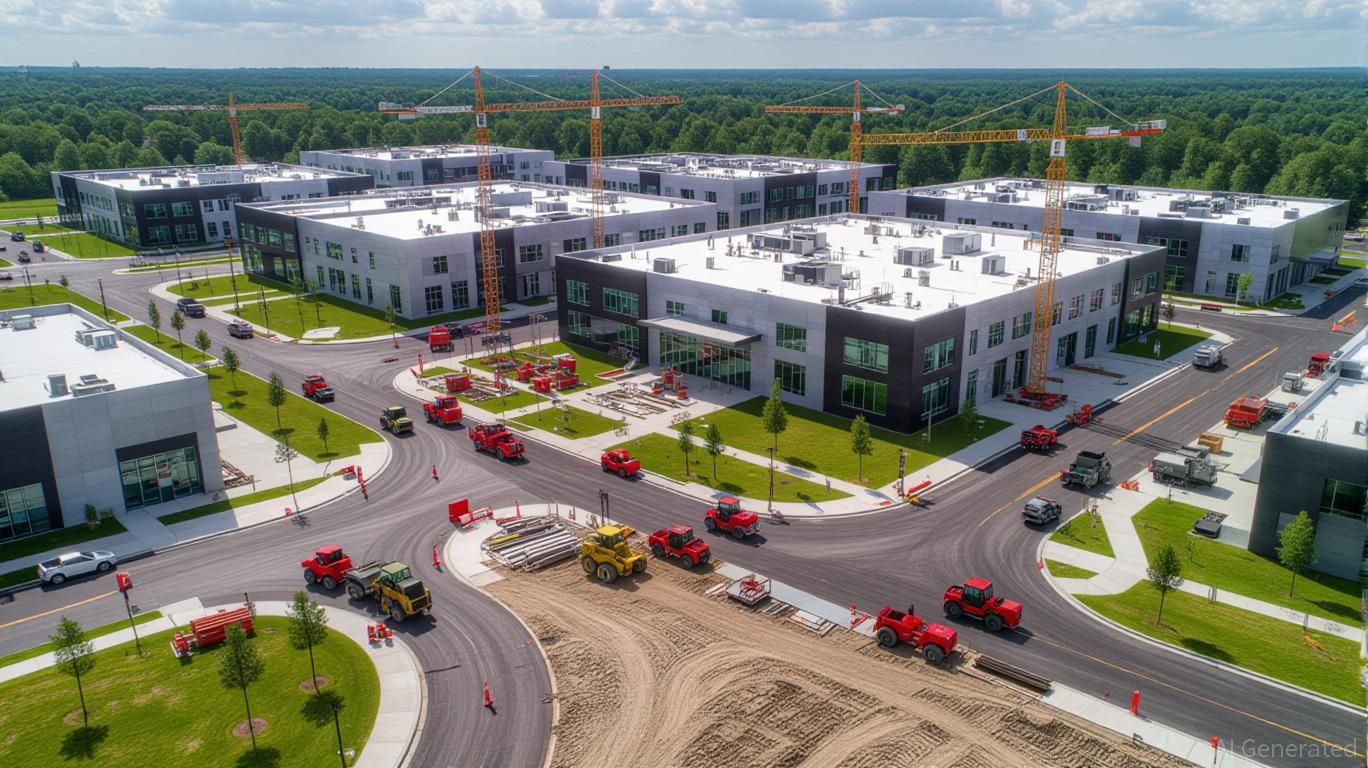The $9.8M FAST NY Grant and Transformation of the Xerox Campus: Maximizing Industrial Property Potential in Webster, NY
- NY's $9.8M FAST NY Grant funds Xerox campus redevelopment in Webster, aiming to boost industrial real estate and advanced manufacturing. - The 300-acre brownfield site will receive infrastructure upgrades, creating 1M sq ft of industrial space by 2025 with proximity to major transportation and talent. - Secondary markets like Webster outperform primary cities in growth, driven by affordability, skilled labor, and public-private partnerships aligning with state economic goals. - Infrastructure investments

The $9.8 million FAST NY Grant dedicated to the
The FAST NY Grant: Setting the Stage for Immediate Development
The FAST NY (Focused Attraction of Shovel-Ready Tracts) initiative, which is part of a larger $51 million program across the state, aims to speed up the preparation of sites for advanced manufacturing and technology sectors. The 300-acre Xerox campus in Webster, previously a brownfield, is undergoing significant upgrades such as road improvements, expanded sanitary sewers, and modernized electrical infrastructure. These enhancements go beyond visual appeal—they are about establishing a practical, adaptable setting for industries like semiconductors, renewable energy, and food processing.
By 2025, the site will feature over one million square feet of industrial facilities, tailored for businesses looking to operate in an area known for affordable labor, a skilled workforce, and excellent access to major transport routes. This initiative supports Governor Kathy Hochul’s goal of building a “sustainable economic ecosystem,” using public-private collaboration to lower entry barriers for companies. For investors, this translates to a location that is not only ready for immediate development but also strategically placed to draw in fast-growing tenants.
Secondary Markets: The Next Wave in Real Estate Expansion
Webster’s transformation reflects a larger movement in secondary markets, where both population and employment growth have outstripped those of major cities. Between 2020 and 2025, places like Raleigh, Nashville, and Boise experienced population jumps of 10% or more, fueled by affordability, flexible work options, and diverse economies. For instance, the Bureau of Labor Statistics noted that employment in non-metro areas rose by 4.8% in 2023, exceeding the national rate.
Although Webster is a smaller market, it shares important characteristics with these thriving areas: its median household income is 27% above that of Monroe County, it boasts a highly rated school district, and its workforce is skilled in precision manufacturing and automation. These strengths make it appealing to industries seeking affordable, qualified labor. The Xerox campus, located near the $650 million fairlife production plant (expected to generate 250 well-paying jobs), further strengthens the local economy.
Infrastructure’s Amplifying Impact
Investments in infrastructure, such as the FAST NY Grant, have a compounding effect, boosting overall economic growth. The improvements at the Xerox campus will not only attract manufacturers but also benefit related sectors like logistics and business services, creating a cycle where public investment spurs private sector growth.
For those investing in real estate, the message is clear: demand for industrial spaces in Webster—whether for warehousing, manufacturing, or distribution—is set to rise, likely driving up property values. According to the National Association of Realtors, secondary markets already feature median home prices about 30% lower than those in primary markets, and multifamily cap rates that are 50-75 basis points higher. As the Xerox campus becomes fully operational, commercial property values in Webster, especially those near the site, could see notable gains.
Data-Backed Trends and Investment Potential
To better understand the promise of secondary markets like Webster, consider these statistics:
These figures highlight a clear trend: secondary markets are not only weathering the post-pandemic landscape but are flourishing. With the Xerox campus aligning with state economic priorities and ready infrastructure, it stands to benefit from this momentum.
Potential Risks and How They’re Addressed
Despite their strong fundamentals, secondary markets do face challenges. For example, Apartment List’s 2024 analysis observed rent drops in certain secondary cities like Boise and Austin. Nevertheless, Webster’s distinct mix of industrial-centric development, significant public funding, and closeness to a major employer (fairlife) helps shield it from such fluctuations. Moreover, converting the site from a brownfield to a modern tech center tackles environmental and regulatory issues that can impede growth in these markets.
Conclusion: A Forward-Looking Investment Strategy
The redevelopment of the Xerox campus in Webster, NY, is a clear demonstration of how focused infrastructure investment can generate lasting value in secondary markets. By aligning with state economic objectives, fostering public-private partnerships, and resolving infrastructure challenges, this project positions Webster as a center for advanced manufacturing and industrial real estate. For investors, it presents a chance to benefit from a market that is both ready for immediate use and strategically set for ongoing growth.
As secondary markets keep outpacing primary ones, Webster’s experience provides a blueprint for finding undervalued assets with strong growth prospects. The essential strategy is to target areas where infrastructure spending directly supports economic development—a proven approach for achieving both capital gains and long-term security.
Disclaimer: The content of this article solely reflects the author's opinion and does not represent the platform in any capacity. This article is not intended to serve as a reference for making investment decisions.
You may also like
Ethereum Updates Today: SharpLink's ETH Sell-Off Fuels NAV Recovery Theories as Crypto Market Declines
- SharpLink Gaming sold 4,364 ETH ($14.47M) to OKX, triggering an 8% stock drop and 42% monthly loss amid broader crypto market declines. - Its mNAV of 0.82 shows a 18% discount to crypto holdings, raising speculation about NAV stabilization or buyback strategies. - Ethereum's $3,097 three-month low worsened unrealized losses for firms like BitMine, with combined 4.17M ETH ($14.5B) but mNAVs below 1. - Staking advantages for Ethereum firms contrast with Bitcoin-centric peers, as SharpLink's $240M unrealize

Intuitive Machines Purchases Lanteris Amidst Crypto Industry’s Struggles with Penalties and Security Breaches
- Intuitive Machines plans to acquire Lanteris for $800M, merging satellite production with in-space logistics to create a $850M annual revenue entity. - Coinbase Europe faces a €21.5M fine for AML compliance failures, while DWF Labs reportedly lost $44M in a 2022 North Korea-linked hack. - A crypto whale opened $140M leveraged short positions against Bitcoin/XRP, reflecting bearish sentiment amid regulatory and security challenges. - The acquisition aims to leverage Lanteris' production reliability for In
HYPE Token Experiences Rapid Growth: Are We Seeing a Temporary Hype or a Genuine Innovation?
- HYPE token surged 64.8% in 2025, driven by institutional backing, tech innovation, and speculative demand. - Paradigm, holding 19.14M HYPE ($763M), wields governance influence but risks whale-driven market distortion. - Hyperliquid's ecosystem includes HyperEVM, staking, and $400M buybacks, creating a flywheel effect for token value. - Partnerships with Phantom Perps and corporate treasuries (e.g., Eyenovia) expand adoption, while HIP-3 decentralizes market creation. - Skepticism persists due to meme coi

IREN's $9.7B Artificial Intelligence Agreement and Profit Jump Fail to Prevent 12% Share Decline
- IREN shares fell 12.37% despite $9.7B Microsoft AI cloud contract and record $240. 3M Q1 revenue, driven by Bitcoin-to-AI pivot. - $384.6M net income turnaround and $662.7M EBITDA highlight transition to vertically integrated AI infrastructure with 3GW renewable-powered data centers. - 140,000 GPU deployment and $1.8B cash reserves contrast with investor concerns over $1B convertible notes, execution risks, and contract dependency. - Microsoft's 10% capacity access with 20% prepayment ($1.9B annualized)
